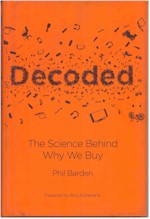 |
|
|
| ||||||
|
|
This page is the original source of this review, though you may also find it on Amazon or other sites. | ||
| Book Reviews Home | Free Audio Books | |
 |
Book Review of: DecodedThe Science Behind Why We Buy Price: $16.99 Availability: Usually ships within 24 hours |
| Review of
Decoded, by Phil Barden (Hardcover, 2013) (You can print this review in landscape mode, if you want a hardcopy) Reviewer: Mark Lamendola, author of over 6,000 articles. This book draws from several existing works, and puts many powerful ideas in one place. I'm not sure there were any new concepts in it for me, but the examples were mostly new to me. Whatever wasn't covered in my graduate marketing courses (early 1990s) has been covered in the literature since then. Now, some people will ding the book for "lack of originality," and that is a mistake. Any serious work in business literature needs to draw from existing data. Making things up is great when you're writing fiction, but not when you're writing something for business. Where originality comes into play is in how the author frames and explains existing, documented facts to teach something to the reader. Mr. Barden's presentation strikes me as original. But is it accurate? Mostly, it is. But in some cases, he misapplies some datum or idea when trying to explain why something is the way it is. He's reaching, rather than reasoning. To me, these mistakes were glaringly obvious and the author should have not made them. An informed reader should be able to spot them at once and none of them undermine the main points of the book, so I won't belabor them here. These exist in every chapter, but are particularly numerous in Chapter 3, "Decoding the Interface." So read that chapter with the proverbial grain of salt when the author tries to explain the science behind why something is the way it is. You should be able to spot the non-sequitors. The author is based in the UK and I am in the USA, so I am unfamiliar with many of the brands he refers to. This was a bit jarring in places; if the author were intending to write for a larger audience than just the U.K., he should have avoided local brands or provided some clue for the reader. For example, rather than just start talking about Dettol, say "Dettol (sanitary wipes)" so the reader immediately knows what that's about. But perhaps this jarring was intentional. It did pique my interest in a particular example, when it occurred. Setting aside this brand issue and the relatively minor accuracy issues, the next question to ask is "Is it useful?" I think it is. Time and again, Barden illustrates a principle that can improve how anyone, whether in marketing or not, produces content. And by "content" I mean anything in which the author intends to communicate effectively, whether to persuade or inform. Whether writing an advertisement or a technical article, you must consider the many "codes" that send a message. That's just for the text, and there's more. How you lay out the ad or article, what graphics you include, and how harmonious the text and graphics are with each other will communicate something. Being aware of this interplay and the coded messages can make the difference between behind highly effective or flopping. The way Barden wrote this book is, to me, an object lesson in how to do exactly what he's talking about. You could learn much from this book by simply scanning the headings, viewing the graphics, and reading the captions. It all fits together, and deliberately observing that pattern is, in itself, a learning exercise. Asking, "Can you learn how to put cultural coding to effective use from this book" is like asking, "Would you take golf lessons from Tiger Woods or guitar lessons from Eric Clapton?" This book makes an excellent addition to the collection of anyone involved in persuasion. I think for people involved in a dedicated marketing role, it's a "must have." In several places, Barden describes discussions he had with clients in those roles. From my own experience in working with media buyers, I found those descriptions bringing back some memories. Some marketing managers, media buyers, and content developers are super-savvy. And others really need to find a different line of work. Those in the middle can raise their game by studying and applying what's in this book. Decoded consists of 6 chapters and "Closing Remarks" (with a blank page between each of these seven) in 256 pages. Each chapter has an excellent summary at the end. It consists of bullet point items under the headings of "What we have learned in this chapter" and "What this means to us as marketers." This is followed by a 9-page reference "Recommended Reading." The index is only two pages long, but for this particular work I think that is the right length. | |
| |||||